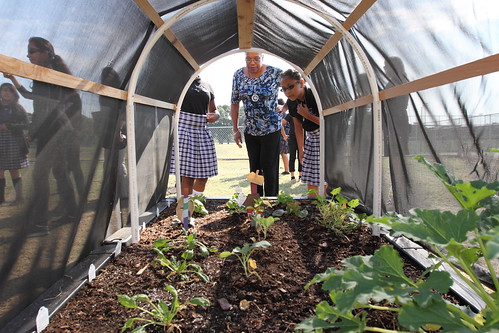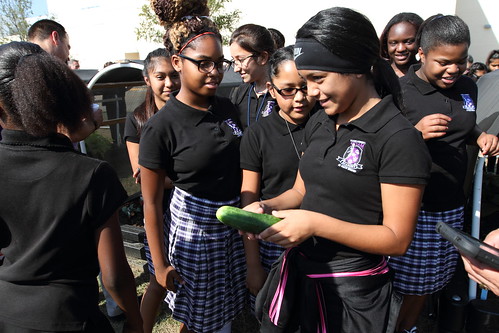
Administrator Audrey Rowe visits the Young Women’s STEAM Academy at Balch Springs Middle School, where students established a school garden as part of their culinary arts program.
School gardens are gaining popularity across the country. In Texas, nearly 3,000 schools participate in farm to school activities. Some of these schools work with Texas A&M AgriLife Extension’s Learn, Grow, Eat, and Go program. Jeff Raska, a school garden specialist with the AgriLife Extension, works with numerous programs and offers practical advice to schools establishing a school garden. Here, he discusses the importance of a strong school garden committee.
By Jeff Raska, Texas A&M AgriLife Extension Dallas County Texas
A school vegetable garden can be a wonderful outdoor classroom for studying natural science. Having worked with school gardens on and off for more than 25 years, I have seen many great school garden programs bloom, and then fade as time passes and school priorities change. For the last seven years, I’ve had the privilege of working with school gardens as a 4-H Club program assistant for Dallas County and have had the benefit of seeing a wide range of needs and challenges that schools face when trying to start a garden. However, the most successful programs have a few important things in place.
One of the first common elements is a dedicated garden committee. The committee can include teachers, parents, community members or school support staff. It’s important to have certain duties assigned to each member. For example, there needs to be a point person who reaches out for help when needed and maintains accountability. This is important because if the garden is funded by outside resources, such as grants or corporate sponsors, certain benchmarks must be met. I have honestly tried to talk some schools out of pursuing a school garden because they didn’t have a committee structure in place. The committee is important for success.
The committee needs to determine why they want to invest time and resources into a school garden program, and how it will benefit the students. The committee should write a list of goals they want to accomplish and the benefits the school garden will bring. Then, they need to balance those benefits with the costs involved such as the startup and yearly maintenance fees; the time it will take out of someone’s daily school duties; the team it will require to schedule and carry out a garden program; and how they will incorporate the garden into the school’s lesson plans. The committee can be responsible for start-up funding and long-term maintenance costs, as well as material procurement and maintenance schedules.
The committee should research and recommend a school garden curriculum that best fits the schools lesson plans and goals. I recommend the Learn Grow Eat Go Curriculum developed by the Texas A&M AgriLife Junior Master Gardener team through a USDA research grant. It not only incorporates the horticultural aspects, but also teaches nutrition, cooking and a classroom exercise plan for a complete healthy living model. I incorporate a nutrition element in all school programs I teach (being primarily Title 1 schools) because nutrition education is important in low-income communities.
The people on the committee will change as the years pass (kids and parents move up, teachers move schools, principals change) so a good foundation committee needs to be established and put in place to keep the garden blooming for years to come. I never use the word sustainable in horticultural systems, as no natural eco system just sustains itself. In the same way that an ecosystem evolves to climatic changes, understand that school garden programs must also plan to evolve to be able to enjoy long-term success.

Students show Administrator Rowe a cucumber proudly harvested from their garden. Members of the school staff, the Texas AgriLife Extension and parent volunteers all helped build and maintain the garden.
No comments:
Post a Comment
Note: Only a member of this blog may post a comment.